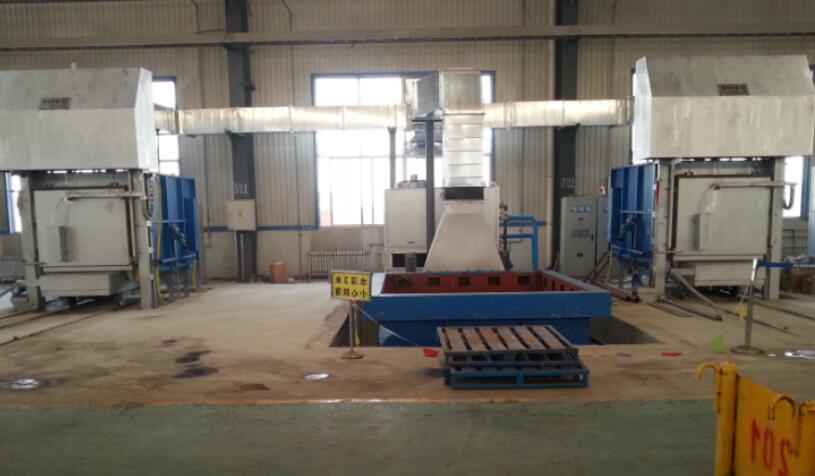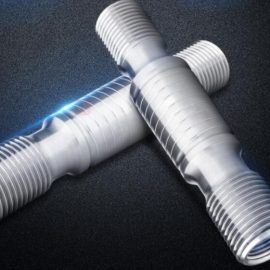Quenching Oil Tank Oil Fume Purification Device
In the process of heat treatment and quenching, metal parts will produce carbon oxide, carbon dioxide, nitric oxide, nitrogen dioxide, sulfur dioxide, water, and a small amount of carbon particles and other harmful substances, which will bring great harm to the factory environment and the physical and mental health of employees. As the national environment advocates more and more stringent requirements for environmental protection and clean production, the emission of oil fume from quenching oil tanks in my country’s heat treatment industry must also meet the requirements of the national environmental department.
1. Quenching oil tank oil fume purification process:
A siphon gas collecting hood with a front fire purifier (independently developed by our company) is installed on both sides of the oil tank. During the quenching process, the exhaust gas rises from the oil surface at the same time, and the fluid changes its flow direction under the action of the fan, and is collected by the siphon type. The hood is instantly filtered and sucked away, and 98% of the exhaust gas is filtered. The siphon type gas collecting hood is equipped with a fire-proof oil fume filter. The fire-proof oil fume filter adopts the principle of filtering mechanical separation (filtering, collision, cooling, adsorption) to remove the oil in the oil fume, and the removal rate is more than 80%. It has a special filter and adsorption material. , This new material solves the weakness of the filtration and adsorption control technology in the application of the large proportion of oil fume, which is difficult to flow, and the pressure drop is large; it solves the problem of low capture efficiency, and achieves the effect of ventilation and separation.
The exhaust gas after primary filtration enters the JKXY-JD high-efficiency purification equipment independently developed by our company through the ventilation duct. The high-efficiency purifier is equipped with a mechanical mist eliminator. First, the oil fume exhaust gas is directly introduced into the mechanical mist eliminator. A large number of layered metal mist eliminator screens are placed in the mist eliminator. It condenses into large oil droplets in the filter screen, and then flows back into the oil collection pan under the action of gravity. The mechanical filter used is called wire mesh demister, which is a typical product in inertial collision demister, and is an efficient gas-liquid separation equipment. It has the characteristics of high oil removal efficiency, simple structure, large void ratio, small pressure drop and light weight. After mechanical filtration, a small part of the flue gas with particles below 0.5um passes through the high-voltage electric field formed between the cathode of the high-voltage DC power supply and the grounded anode. Due to the corona discharge at the cathode and the ionization of the gas, the negatively charged gas Ions, under the action of the electric field force, move towards the sun plate, and collide with the smoke particles during the movement, so that the dust particles are negatively charged. The gas is deposited on the anode plate, and the purified gas is discharged out of the purifier, and is discharged in an organized high-altitude under the action of a high-efficiency centrifugal fan.

2. Oil fume purification equipment and materials
(1) The design of the gas collecting hood is italic. The hood body can be disassembled and assembled. That is, to achieve a good exhaust effect and facilitate the normal operation of workers, it does not affect the later maintenance of the furnace door lifting equipment.
(2) The air volume regulating valve controls the air volume of each exhaust pipe.
(3) By calculating the exhaust air duct of a single tempering furnace, the material of the air duct is galvanized sheet (saving rust removal, surface painting, corrosion resistance, saving man-hours), technology: bending, processing, welding.
(4) Main air duct: The material is galvanized sheet (saving rust, surface painting, corrosion resistance, saving man-hours), technology: bending, processing, welding.
(5) JKXY-JD-18 industrial oil fume purification device, two tempering furnaces use one high-efficiency purification device, which simplifies the treatment process and reduces economic investment. The same purification effect can be achieved.
(6) Fan, the fan adopts high-efficiency, low-noise, corrosion-resistant, high-temperature resistant centrifugal fan.
4: Processing Process Diagram
Collecting hood—–air volume control valve—–soot purification device—–centrifugal fan—-15m exhaust chimney
3. Main performance and characteristics of the fume purifier:
3.1 Front fire filter
The fire-proof oil fume filter adopts the principle of filtration mechanical separation (filtering, collision, cooling, adsorption) to remove the oil in the oil fume.
It has a special filter and adsorption material. This new material solves the weakness of the filter and adsorption control technology, which is difficult to flow freely and large in pressure drop in the application of the filter and adsorption control technology. It also solves the problem of low collection efficiency and achieves the effect of ventilation and separation.
3.1.1 How to use
The structural characteristics of the product make it occupy a small space, and it is suitable to be installed in the position of the deflector of the collection fume hood, which plays the role of oil filtering and fire prevention. The cleaning is simple and convenient, and it can become an integral part of a healthy and environmentally friendly fume extraction hood. The product can also be matched with other facilities to form a composite type.
3.1.2 Technical features:
★Long life, high temperature resistance, corrosion resistance;
★Good cooling performance, strong oil fume capture, easy to separate oil and vapor;
★The filter element has high porosity, low resistance, good ventilation performance and large oil storage capacity.
3.1.3 Advantages of front-end purification:
★No energy consumption and low operating cost:
This product runs without water and electricity consumption, without changing the original ventilation power system, without replacing parts, and without additional costs. Significantly prolong the cleaning cycle of the pipeline and reduce the user’s expenses.
★Good purification effect:
The back-end purification wind speed is faster and the purification efficiency is low; while the front-end purification wind speed is slow and the purification efficiency is high.
★It is beneficial to safety and fire prevention:
When the equipment is running, the oil is blocked at the front end, and there is basically no oil in the air duct, which is conducive to fire fighting;
★Easy to install and maintain:
The equipment is placed at the position of the fume hood deflector, and the installation and disassembly are very simple. When cleaning this product, soak it with degreaser or diluted strong alkali and warm it, and then rinse it with running water, it can be restored to new condition.
3.1.4 Technical principle:
Fire-resistant oil fume filters are the most suitable products for industrial manufacturing to remove grease. It solves the disadvantage of difficult gravity flow and large resistance of oil fume in the application of filter adsorption control technology, and solves the problem of low capture efficiency of mechanical method control technology. A balance of ventilation and decomposability is achieved. A 7-layer filter screen device is used, the first and second stages prevent large objects from entering and rectifying; the oil removal filter has two stages, which is composed of 0.04-0.1mm alloy wire, and its cross section is a trapezoidal arc surface. The turbulent flow in the reverse and downward directions increases the contact surface and discharges the accumulated oil.
3.2. Working principle of mechanical degreasing mist unit:
First, the oil fume exhaust gas is directly introduced into the mechanical demister. A large number of layered metal demister screens are placed in the demister, and the air flow touches the filter screen to bond the mist droplets and condense into large oil droplets in the filter screen. , and then return to the oil collecting pan under the action of gravity. The mechanical filter used is called wire mesh demister, which is a typical product in inertial collision demister, and is an efficient gas-liquid separation equipment. It has the characteristics of high oil removal efficiency, simple structure, large void ratio, small pressure drop and light weight. After mechanical filtration, a small part of the flue gas with particles below 0.5um passes through the high-voltage electric field formed between the cathode of the high-voltage DC power supply and the grounded anode. Due to the corona discharge at the cathode and the ionization of the gas, the negatively charged gas Ions, under the action of the electric field force, move towards the sun plate, and collide with the smoke particles during the movement, so that the dust particles are negatively charged. It is deposited on the anode plate, and the purified gas is discharged out of the purifier.
3.2.1 Features of the whole system:
⑴. Demisting host stainless steel wire mesh demister
According to the size of the oil mist particles and the requirements for demisting, choose mist eliminators with different wire diameters and different weaving methods; adopt mist eliminators with different thicknesses and different arrangement structures according to the specific gravity of the oil mist to separate the oil mist. the goal of. The primary filter adopts a split fume hood structure, which is easy to install and clean. The secondary filter stainless steel wire mesh mist eliminator adopts the layered three-stage placement method, which increases the specific surface area and improves the demisting efficiency of the stainless steel mist eliminator. The diameter of the mist is 0.076-0.4 and the particle size of the mist is less than 5 microns, and the demisting efficiency of the wire mesh mist eliminator can generally reach 95%.
The defogging process is mainly based on mechanical defogging, with high reliability and convenient use and maintenance. It is a very mature and extensive filtration method, especially suitable for large and medium-sized centralized gas-liquid separation. For mist eliminators used in mechanical demisting, different wire diameters and materials (metal, non-metal and metal, non-metal) can be selected according to different particle sizes, and different types of gas-liquid mist eliminators can be woven. By cleaning the mist eliminator, the mist eliminator efficiency is maintained without affecting the performance of the mist eliminator.
3.2.2 Auxiliary device for non-thermal plasma electrostatic purification
The non-thermal plasma electrostatic purification part of the power supply adopts the power conversion method controlled by PWM to generate high-frequency power supply, which has the characteristics of wide supply voltage range, high conversion efficiency, high reliability, continuously adjustable output power, low temperature, and long-term continuous operation. In normal operation, there is no “blocking” phenomenon for corona power sources such as smoke, oil, etc., and the electrode has strong adaptability. When the high voltage is open, the output voltage and current are equal to zero, and the operation is reliable and does not interfere with the power grid. When a short circuit or overcurrent occurs, the controller protection circuit will cut off the high voltage output, and the static indicator light will be off (green light).
Main features:
A. Small size, light weight and long service life;
B, flame retardant, moisture-proof;
C. When the electric field body is short-circuited or discharged, it can be safely protected for 5 seconds to start.
D. Frequency: Adjustable high voltage frequency.
E. Input voltage: AC 220V-240V 50-60Hz.
Annealing Process For Reducing Remanence Of Nanocrystalline Magnetic Cores Silicon Steel Sheet Iron Core Annealing Furnace Effect of Annealing Treatment On Properties Of Fe-Si-B-Cu Amorphous Nanocrystalline Alloys


Contact us
Your email address will not be published. Required fields are marked *